Life & Island Times: Cleveland Avenue Tenacity
Author’s note: With the recent respite from the Asian war drum rolls, I waded through my faded memories, mementos and few surviving photographs of the streets of South Bend, Indiana, dating from 1969 through 1971. They opened a window for me to revisit the America of my past and present. The next few pieces are the result.
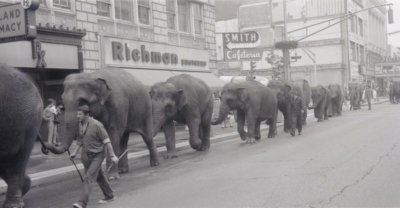
Elephants and other circus animals from the Ringling Bros. & Barnum and Bailey Circus were paraded
while the circus was in South Bend during September 1970. School classes were dismissed early to
allow students to watch the parade. (Courtesy from an old front page clipping of the South Bend Tribune)
On an off chance, I pulled out the contents from two faded manilla envelopes from a long sealed plastic storage container in the front room closet. It was an amalgam of stuff — unlabeled Kodak photo prints, yellowed Polaroid snaps, postcards, napkins, brochures, newspaper clippings, and cryptic notes. The resulting mental images from this long ago collection I confronted were faint echoes of American voices that are for the most part no longer heard.
I set them aside because I couldn’t process my reactions to them, Two days later I went throught the pile again. This time, much more slowly. Clarity came in bits. Voices. Feelings. Scents. Thoughts.
Again I delayed, I needed more time. Lots more time.
Finally I became clearer on what I was seeing. Feeling, Thinking.
——-
More than a few of the South Bend’s current residents have now come to represent the “underclass” in America that remains little to poorly understood and easily forgotten. The American Dream left neighborhoods like this and their people behind.
When I lived in a South Bend apartment from 1969 through 1971, it was a time of war, the war in Vietnam, a war America came to regret. Many men of South Bend fought there. More than a few died there. Those who survived, came home, found jobs, married, and had children who have now grown into the adults who, with their children, face yet another interminable war.
With its now rundown sidewalks and shabby houses, my street — Cleveland Avenue — was once America the Beautiful. Full of American industrial, golden-age families, their children, tidy yards and houses. Today its residents are not working class, let alone stylish; more than few go barefoot. It was a friendly neighborhood back in the day, with residents enjoying life’s daily joys, sharing sadness, good weather and bad.
Though my old street and neighborhood are now blighted places, its spirit, and the spirit of those times, live on in my heart. I prefer to keep alive the memories of late summer circus parades down the town’s main drag just blocks from my apartment, the city’s streetcars, its pre-mall downtown department and specialty stores, and the regional commuter railroad service to Chicago and northwestern Indiana steel mills and factories.
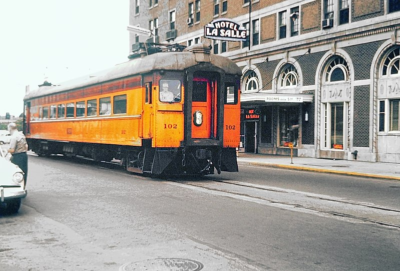
South Shore regional commuter rail car on South Bend’s Michigan Avenue
My Cleveland Avenue was a short street of several blocks that traversed the western outer edge of the downtown area of one of America’s heartland industrial cities and key manufacturing centers of WW II ‘s Arsenal of Democracy. It is far away from where I sit as I type this in Georgia’s Coastal Empire, and a huge distance from a world almost five decades later that now includes instantaneous text, image and email exchanges, 24/7 television, and a pervasive globalism that has made many things begin to look, taste and feel the same almost everywhere one goes.

Three early 1970 South Bend greasy spoons less than a mile from my Cleveland
Avenue: Silver Tower (l), Sally Swiss (c) and 24 Hrs Coffee Shop (r). They are all gone now.
This neighborhood street scene seems even further because it no longer exists as a treelined street flanked by post WW I era homes as it was then. Today, the trees and homes along those blocks have been mostly cut down and demolished and in their place are weed infested vacant lots. Like many other northern Indiana rust belt towns, it has fallen on hard, hard times — much like Detroit.
1969 was a time, as anyone then alive would remember, of monumental change accompanied by great tumult in American life. Vietnam war. Civil rights movement. Boomer counter culture. Street riots and protests. Cities burning. Yet, it was also a time, especially in the heartland of America, when asking questions about the foundations of American society was more or less considered unpatriotic by young people and their parents, save for those folks living on local college campuses. I remember it as a time of tension, but of a tension that seemed to be ultimately a medium for much creativity.
Life on Cleveland Avenue was a time of much light and hope. The terribly somber and despairing issues of the war in Southeast Asia, the Watts and Detroit riots, generational conflict, assassinations of leaders — the Kennedys, Dr. King, and Malcolm X — were still distant things. Within the two years of my residence, Cleveland Avenue had been touched by all of the effects of those distant lightning storms. During the ten years that followed my departure, globalization, the rust belt, and America’s drug culture would serve to gut my neighborhood.
I have fond memories of the special sense of community that pervaded this hard-working-class street where every house had a front porch and people yelled back and forth. Adults and children played games together on the sidewalk and in the middle of the street. People lived, laughed, and argued out loud in heavily accented voices, amongst each other.
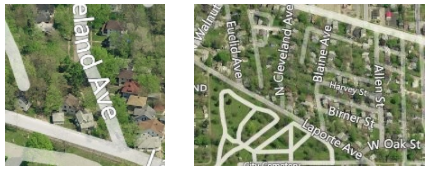
GoogleEarth views of Cleveland Avenue
The street itself was not particularly different from other streets that surrounded it in the area. Residents were largely working-class and blue-collar, though of many different backgrounds and origins. Caucasian, some Appalachian, more than a few African Americans and Latinos, and lots and lots of eastern European ethnics (at one time I could order a short beer at local taverns in four different Slavic tongues). We occupied two-story homes, which were often split into many rental units. From the beginning, I lived in an upstairs apartment at 511 Cleveland just three houses down from the leafy, shady green spaces of the City Cemetery.
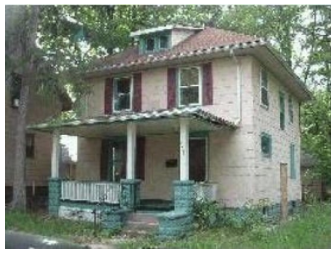
509 Cleveland Avenue (511 was demolished years ago)
While all of us had been taught that all men were created equal, South Bend’s neighborhoods were mostly racially and economically divided, with the middle and professional classes occupying the suburbs, working-class living mostly in the near-city neighborhoods, and the poor, mostly brown and black classes living in crumbling slums near the industrial factory areas in the city’s southwest.
Regardless, I really liked South Bend and felt lucky to be around the people of Cleveland Avenue, who offered me kinship and conversation. Their zest and spirit, in the face of their daily struggles, opened my eyes. Their nobility and trust in a brighter future captured my heart and unknowingly offered me inspiration and a sense of direction and a roadmap for the approaching life I would face upon graduating college in 1971.
During the past five decades, I traveled worldwide, searching for and gathering impressions of our “One Human Family” (an expression that is the official motto of Key West, Florida). With time and experience, I have learned more about some of the harsh and complex realities of the world, its politics, and the interplay of power and common everyday humanity. I’ve grown to appreciate more than ever the importance and meaning of my Cleveland Avenue sojourn.
Nowadays, my old street’s few blocks south of US 20’s Lincoln Way West are beset with 911 calls, cop cars and shootings. Police reports tell of someone driving up in a car and opening fire on a house, hitting one person in the leg and the other in the abdomen, while they were sitting on the front porch.
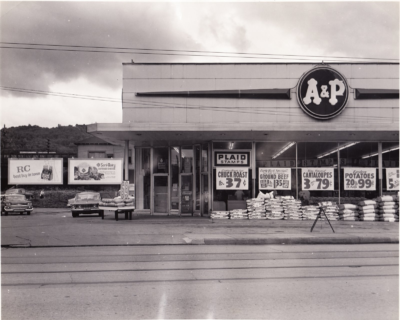
I worked at a downtown A&P store on Lincoln Way West from 1969 to 1970.
It was less than a half mile southeast from my apartment. The surrounding
neighborhood suddenly became so dangerous that I was told to park my 80cc
motorcycle in the store’s stockroom. I had more than a few knives and guns
pulled on me while I was working there. Fortunately, no injuries resulted.
With the luxury gift of time, I have been able to recall more of the details of the times during those two years — closed casket funeral masses for returning war dead sons, small daily flare ups of rising racial tensions, increasing crime, open drug dealing on the street, growing long term unemployment, factory relocations or shutterings, national wage freeze, manufacturer bankruptcies, and the beginning of the hollowing out of the neighborhood as the older retirees started to move out or die off, leaving their homes to quickly fall into disrepair as rental properties.
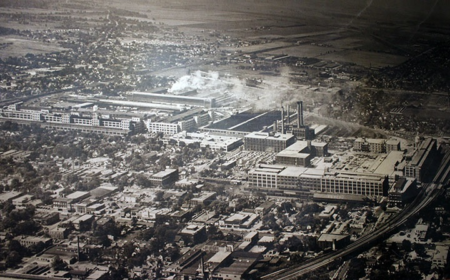
Main Studebaker complex in Southe Bend at its peak. This photo, looking southwest, shows the massive
complex that Studebaker had during WW II. Two of the buildings still exist, which are located to the far
right, or north, and are right up against the railroad tracks. (Courtesy Studebaker National Archives)
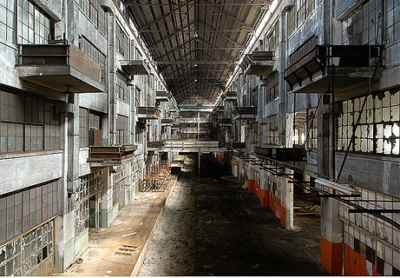
Interior image of one of the many Studebaker plants in South Bend. The mid 60s shuttering of these
plants, whose work force was nearly a quarter African-American, hit the community especially hard.
I miss the amazing spirit and rich, honest expression of life that these people offered me while asking for nothing in return. This period of my life and the people on my avenue silently stayed with me.
My Cleveland Avenue period began during a formative time of my life when I was barely 20 years old. I saw the birth of my first child there.
Tenacity was the singular quality that I saw along that street every day. It was manifested by men and women waking up early each weekday, showering, dressing and heading off in the darkness to jobs at nearby automotive plants and at far away Gary, Indiana, steel mills. They made quality stuff and were paid good wages. Their kids were good citizens, athletes, nerds, and bobby soxers who dreamed of being the first in their family to go off to college one day. Like most things during that time, younger siblings often followed their older siblings’ paths. Off to war, to college, to work, to marriage and so on. It was a comfortable cycle where one’s initial struggles would not last forever. Tenacity would overcome obstacles. I learned to be tenacious from them.
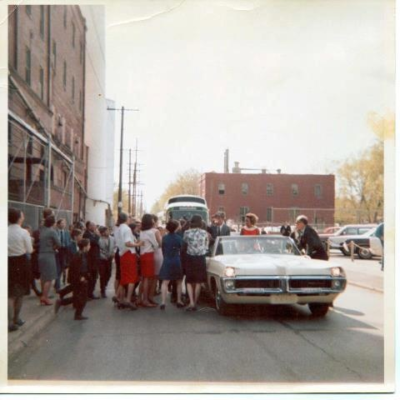
Bobby Kennedy visited South Bend twice during the 1968 presidential
campaign in April and May – the last time was five weeks before he was assassinated.
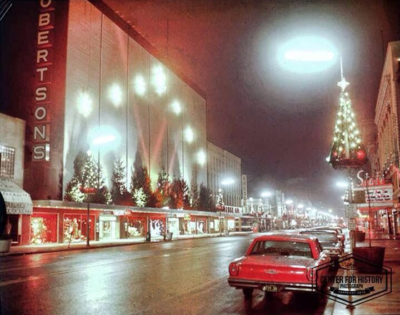
Downtown South Bend, Christmas 1969
Today, my South Bend born daughter, son in law and three adult grandchildren live less than a mile and a half away from that Cleveland Avenue block. They moved there from Tennessee almost twenty tears ago to a downtown Victorian era neighorhood that was struggling to return back to life. It has year by year recovered with the surrounding blighted neighborhoods now slowly following suit.
In South Bend, tenaciousness abides.
Copyright © 2017 From My Isle Seat
www.vicsocotra.com
